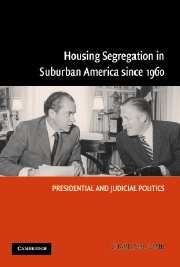Book contents
- Frontmatter
- Contents
- Preface and Acknowledgments
- Abbreviations
- Housing Segregation in Suburban America since 1960
- 1 Separate Worlds, Separate Lives
- 2 Lyndon Johnson and the Fair Housing Act
- 3 George Romney's Blueprint for Suburban Integration
- 4 Richard Nixon, Centralization, and the Policymaking Process
- 5 Suburban Segregation from Gerald Ford to Bill Clinton
- 6 The Federal Courts and Suburban Segregation
- 7 Conclusions
- Appendix
- Bibliography
- Index
5 - Suburban Segregation from Gerald Ford to Bill Clinton
Published online by Cambridge University Press: 21 November 2009
- Frontmatter
- Contents
- Preface and Acknowledgments
- Abbreviations
- Housing Segregation in Suburban America since 1960
- 1 Separate Worlds, Separate Lives
- 2 Lyndon Johnson and the Fair Housing Act
- 3 George Romney's Blueprint for Suburban Integration
- 4 Richard Nixon, Centralization, and the Policymaking Process
- 5 Suburban Segregation from Gerald Ford to Bill Clinton
- 6 The Federal Courts and Suburban Segregation
- 7 Conclusions
- Appendix
- Bibliography
- Index
Summary
The politics of suburban segregation did not end after Richard Nixon left the White House on August 9, 1974. Instead, Nixon's influence in fair housing persists into the twenty-first century. This chapter shows how Nixon's basic suburban housing policy has survived five subsequent presidencies and remains the policy of HUD. Chapter 6 argues that President Nixon's appointment of federal court judges has also left a legacy adverse to the cause of fair housing and suburban integration.
Naturally, other factors have influenced fair housing policy since the 1970s, and it is difficult to know precisely how much impact Richard Nixon had on subsequent presidents, HUD, and the federal courts. Presidential influence, as noted earlier, is not usually amenable to precise measurement. Moreover, Nixon's policy did not strictly determine the policies of subsequent presidents, especially those of Jimmy Carter and Bill Clinton. Nixon nevertheless left a lasting imprint by seizing policymaking power from his HUD secretary, centralizing that power in the White House, and narrowly construing the meaning of the Fair Housing Act to avoid the political consequences of the suburban integration issue in the 1972 presidential election. By these actions, one president established a powerful precedent that no subsequent chief executive has overturned. The core reasoning of Nixon's 1971 policy statement remains the status quo for federal policy on suburban housing integration to this day.
- Type
- Chapter
- Information
- Housing Segregation in Suburban America since 1960Presidential and Judicial Politics, pp. 165 - 203Publisher: Cambridge University PressPrint publication year: 2005



